 |
 |
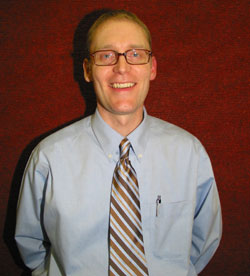
|
|
Ron DeClerck, B.S., Medical & Health Services Manager, Medical Records Administrator, Clinical Center, National Institutes of Health (Related career, Medical Records Technologist)
|
1. I chose this career because...
2. My workday involves...
3. What I like best/least about my work …
4. My career goals are...
5. When I'm not working, I like to...
6. Faith, inspiration, and advice…
|
|
1. I chose this career because...
|
Back to Top

|
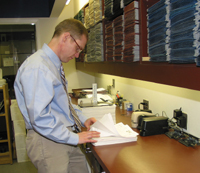
|
|
Ron DeClerck’s detail-oriented personality serves him well when he is analyzing medical record reports for legality and completeness.
|
I chose to become a medical records administrator after exploring my career options through career counseling, which included taking interests and aptitude tests. I have a detail-oriented personality and prefer organization. My interests, counseling, and research, all pointed me to this field. Through the U.S. Department of Labor, I discovered it was one of the fastest growing industries in which to work due to the aging American population. It was also exciting to consider being part of an industry undergoing the technological change from paper to electronics.
Work History
I transferred to the heath information field after working in different careers. After completing my degree in hotel information management, I worked for several Texas Holiday Inns. Five years later, I worked as a flight attendant for American Airlines (AA).
My Career Transition
I left AA and returned to college for 2 years to obtain a bachelor of science degree in health information management at the State University of New York (SUNY) Institute of Technology at Utica/Rome. I went to school full-time and worked part-time. For the first 6 months, I worked in a record store. (This was always something I wanted to do). I worked the final year and a half in a small hospital in Hamilton, NY, as a release-of-information clerk (functioning as a medical record technician).
The transition was a big one, mainly in down-shifting my personal finances for 2 years. Prior to this undertaking, I had never worked in the healthcare industry. I was gambling on my ability to focus and succeed. I would be remiss without mentioning that I was blessed with the support of family and friends throughout the transition to my new career.
Two years later, I graduated and began work as a medical record administrator in the Medical Record Department at the NIH Warren Magnusen Clinical Center. I began work in the Medicolegal Section handling release of patient information. After 3 months, I was transferred to the Credentialing Services Section, and helped to ensure all members of the medical staff were properly credentialed. Later, I was again transferred to the Record Management Section as the assistant section head. The Record Management Section is the primary area responsible for the routing and tracking of all patient medical records for the Warren Magnuson Clinical Center. I have been the Record Management Section Head since August, 2002.
MRAs & MRTs – Certification
Generally, a medical record administrator (MRA) manages work processes and supervises medical record technicians (MRT) in a medical record or health information department. An MRA requires a bachelors degree in health information management, whereas an MRT requires an associates degree.
The American Health Information Management Association (AHIMA) is the professional association that supports all health information professionals. AHIMA administers tests on an annual basis to attain professional designations, such as a registered health information administrator (RHIA) or a registered health information technician (RHIT). Once a test is passed, each member is required to show proof of continuing education credit hours on a biannual basis to maintain their specific professional designation(s).
To become an MRA at NIH, an applicant is advised to have both a bachelor’s or associate’s degree, and RHIA or RHIT accreditation. However, an MRT need not have any degree or related work experience. Having a degree or related work experience helps a candidate, but is not required.
Education
- Bachelor of Science Degree, Hotel Information Management, Rochester institute of Technology, Rochester, New York
- Bachelor of Science, Health Information Management, State University of New York (SUNY) Institute of Technology at Utica/Rome, Utica, New York
- Registered Health Information Administrator, American Health Information Management Association (http://www.ahima.org/), Chicago, Illinois
|
|
2. My workday involves...
|
Back to Top

|

|
|
Ron DeClerck searches among the thousands of medical records in the Medical Record Deparment's filing system to retrieve a patient’s file.
|
My typical workday involves my administrative responsibilities in the Record Management Section of the Medical Record Department, which is open 7:00 a.m. – 6:00 p.m. I typically arrive at 6:10 a.m. and work until 4:30 p.m. – 5:00 p.m.
Major Responsibilities
- Managing and Supervising - As a medical records administrator, I manage the section and supervise the employees. Our section includes the following 13 employees and their responsibilities: one lead medical record technician (MRT) who acts as a floor supervisor and covers for me when I am absent; two MRTs work the front desk; one MRT works on discharged inpatients and inventory of supplies; another works on outpatient first visits (a special process) and audits contractor work; one MRT is responsible for all inactive records and maintenance of the record location database, and various other tasks; six other MRTs work on a variety of tasks on a rotating basis; and we have an IT specialist who works on the maintenance and data entry of protocol consents, new individuals requesting access to medical records or those whose access privileges have expired, and statistical tracking.
We also have 15 contract employees. These employees work for an outside company and complete tasks for us, on a contractual basis, to help us achieve our departmental mission and goals. They complete our record filing, loose report sorting, stapling and filing, each business day between 5:00 p.m. and 6:00 a.m. They also complete several special projects for us. I am responsible for ensuring that their work is efficiently completed and that they interact effectively with record management personnel. I have also been appointed project officer for the new contract due to begin in 10/04, and was responsible for writing the bulk of the contract.
- Routing Medical Records – The Record Management Section is the main area that routes and files medical records for patient appointments and research requests in the Warren G. Magnusson Clinical Center at NIH.
When patients have scheduled appointments, we route the patient’s files to the appropriate clinic location early in the morning on the day of the appointment. Unexpected and walk-in patient medical records are brought directly to the clinic by hand or by an automated cart system that circulates throughout the Clinical Center.
Research requests include all record requests other than those needed for patient care. These requests may be to abstract data for research papers, for a practitioner to preview records prior to seeing patients, for internal or external audits, and for a variety of other reasons.
- Retrieving, Tracking, and Filing Records - There are many rules governing the process of patient record retrieval. Without these rules, records would remain overdue for long periods of time, and not be available for patient care when needed. One rule is that every request must be submitted in writing for each record we retrieve. We retrieve well over 100 records per day.
Each of our employees uses a computer database to track and retrieve inactivated medical records or records that haven’t been needed for patient care for over 3 years. Records not needed in the past 5 years are on microfiche, and all others are in paper form. This database helps us know the exact location from which to pull each inactive record. We also use PCs to monitor the hospital appointment system and to accomplish other smaller tasks. Otherwise, work completed in the section is quite physical (e.g.: pulling records, climbing ladders, pushing heavy carts of records, and operating a mobile tram-type cart system to shuttle records to clinics).
The Record Management Section operates in a very low-tech environment. We utilize a manual “record locator” to track all patient records. Medical Record pockets on this locator correspond to each record and are placed inside a larger plastic pocket on the front of each record folder. When a record is signed out, a charge-out slip is placed both inside the paper pocket, and the plastic pocket on the front of the record for tracking purposes. The Clinical Center plans to implement a new automated tracking system using bar codes and wand readers sometime in 2005.
Records are filed using a terminal digit filing system. This numbering system is formulaic and helps ensure no area of the files is more compact and crowded than another.
- Customer Service at the Front Desk – The Record Management Section provides quality customer service at our front desk to practitioners and researchers on-demand by responding immediately to their customer service requests. Research requests are pulled on-demand for 5 or less records. We require 2 business days to retrieve 5 or more paper records and all records on microfiche.
Each night we write memos to clinic staff indicating which of their patient records needed for appointment are currently signed-out to another clinic, and to which practitioner. If that record is returned to us overnight, we forward it first thing the next morning to the requesting clinic. If it is not returned, the requesting clinic is responsible for contacting the other clinic that signed it out as indicated on the memo. If the requesting clinic still cannot locate the record, we intervene on their behalf to track down the record. Approximately 50-150 records are returned to the Record Management Section between 6:00 p.m. and 6:00 a.m. each day.
The Record Numbers
The Record Management Section has roughly 100,000 active paper records, an additional 20,000 or so inactive records, and about 1,000,000 retired records on microfiche. All but about 10,000 inactive records (which are stored offsite in a warehouse) are in our department in the Clinical Center for ready access.
Records are considered active if the patient was seen at least once in the last 3 years. After that, records are retired. Until now, retirement has meant conversion to microfiche. However, through an outside contractor the Medical Record Department is about to convert all inactive records to electronic format using digital scanning.
Access Database and Patient Confidentiality
We maintain an Access database that contains all individuals approved to review records for research-related purposes. All members of the medical staff are automatically approved for research access. All other individuals requesting access must submit a form signed by their institute branch chief or clinical center department head, clinical director, and the director of the Medical Record Department. Once it is submitted and approved, these individuals have access to patient records for one year and are added to the Access database. A renewal form must be submitted to the Record Management Section each year to maintain continuous access.
Patient confidentiality is the single most important aspect of our job. Each employee of the Medical Record Department must sign a Confidentiality Agreement and E-mail Agreement on an annual basis promising to strictly protect patient confidentiality in every way possible. Anyone not in the Access database, on the medical staff list, and/or anyone without current NIH identification may not view patient records. To further protect patient confidentiality, no medical record is permitted to leave the Clinical Center for any reason.
Eventually, patient records will be web-based for review by any NIH practitioner with a “need to view”, with secure firewalls to prevent unauthorized viewing. This is a few years away.
Additional Roles (I wear many hats in the course of my duties…)
- Facilitator - My job involves problem solving at least 50% of the time. Along with my teammates, I help facilitate the prompt and efficient care of each patient who comes to the Clinical Center by providing a complete and accurate record whenever it’s requested. Likewise, I help researchers find whatever it is they need help locating. Last, but not least, I help my Record Management teammates by being available to help them through whatever struggles they encounter. Facilitation is a big part of my job.
- Phone Operator - The Record Management front desk employees are primarily responsible for manning the phones. However, everyone on staff must be available to answer the phone and provide prompt, polite and efficient assistance to each caller.
- Personnel Specialist – As a supervisor of 13 individuals, I must know, to the best of my ability, regulations, laws and guidelines regarding employee benefits, leave, payroll, training, etc…. Each new supervisor best does this by researching, reading, networking, and through experience.
- Sounding Board - When customers, peers or teammates need to vent or need help to solve a problem they often come to me. Most of the time I can do something to tangibly help them. When I can’t, I become the sounding board. I put aside what I’m doing and try to understand their point of view. I try to present alternatives that may improve their situation, if not to fully resolve it.
- Mentor - I consider myself a mentor to the staff of the Medical Record Department. I try to act as a mentor by passing on information, leading by example, and walking my talk.
|
|
3. What I like best/least about my work …
|
Back to Top

|
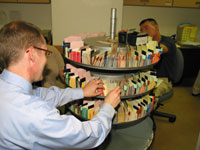
|
|
Ron DeClerck looks up the current location of a specific medical record on the Record Locator.
|
What I like best about my work is that our department has an organized set of processes that ensures proper patient care and customer service. While we still operate with a manual system that allows room for error, we still team together to make very few errors and deliver fine customer service.
What I like least about my work is the long hours. Working between 10 and 12 hour days is the norm for me.
|
|
4. My career goals are...
|
Back to Top

|
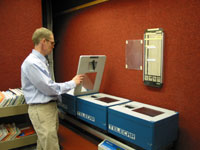
|
|
Ron DeClerck uses a mobile tram-like system that shuttles patient’s medical records to NIH clinics.
|
My career goals are to do the best job I can every day. I’m satisfied with my current position, and learn more every day about how to do it smarter and better. Masters degrees are available for administrators, but I personally don’t wish to return to college at this time.
|
|
5. When I'm not working, I like to...
|
Back to Top

|
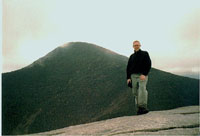
|
|
Ron DeClerck hikes in the Adirondack Mountains of New York.
|
When I’m not working, I enjoy spending time with my wife, attending church, and working on the house and lawn. I also am happy traveling, especially taking long, scenic road trips away from the interstate highways, and listening to many different types of music.
|
|
6. Faith, inspiration, and advice…
|
Back to Top

|
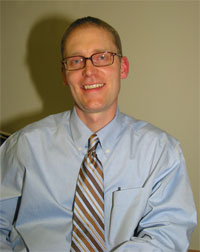
|
|
| |
Ron DeClerck advises “Follow your heart and choose to do what you know you’re adept at.”
|
I’m a big believer in spiritual faith and Steven Covey’s 7 Habits of Highly Effective People.Both things have led me to “dive off the diving board” and leave one career for a more satisfying one. Both things have also led me to my lovely wife. When I’m concentrating on these two strong influences in my life, along with my wife’s constant inspiration, I’m at my best.
I could not see myself in my previous careers for my whole life. If you find yourself in that situation, I recommend seeing a career counselor and seeking motivation through Covey’s book or some other source of inspiration.
Follow your heart and choose to do what you know you’re adept at.
|
|
|
|
 |